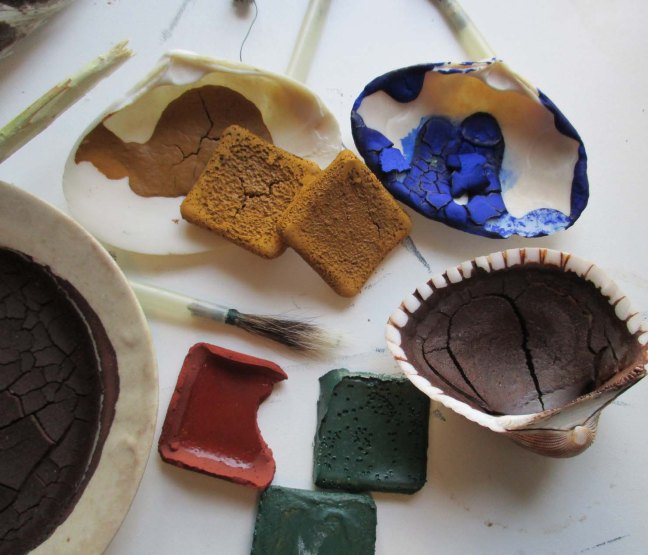 I’ve been researching this topic in earnest since September of 2015. Make some paints, I thought. Give period painting lessons. It’ll be fun.
I’ve been researching this topic in earnest since September of 2015. Make some paints, I thought. Give period painting lessons. It’ll be fun.
It’s been more like riding the many-headed Hydra- which head do you bridle? I’ve been more or less tackling them all. I haven’t found anyone who knows about early watercolors, but I worry that an expert will turn up as soon as I think I’ve got this all together and I’ll have been reinventing the wheel.
Documentation: Coming right along. I started keeping an annotated bibliography to keep track of what I had read, and it’s over 5 pages now. I’m keeping a binder for scribbled notes and photocopies.
Brushes: Documented. Have squirrel tails and feathers. Need to practice making brush heads and destruction test a few to see how they hold up.
Paints: I know the ingredients that went into them, but Ackermann’s recipe leaves something to be desired. Proportions vary for each pigment. Right now, I can mix paints in the pre-1770s manner, globs of paint in a shell, but I can’t get the right consistency to make them into hard cakes. The cakes are supposed to be hard, but they’re more like taffy and I have to pry them out of the mold. Paints are usable, so that’s not my most pressing problem.
Paper: Paper is several kinds of problem. I don’t expect to teach people to draw in a single 15 minute session, so I plan to present them with a selection of period engravings; fashion plates, architecture, political cartoons, and so on. I need to source some high quality, copyright free illustrations from the right time period. Quality/image size is proving a problem.
Watercolor paper needs to be thick, to reduce wrinkling and buckling from the water. “140 lb” paper is the thinnest you can expect good results from. It doesn’t come in standard 8.5″x 11″ size, and when I did cut it to that size, it was still too thick for a home printer to handle. The ink will have to be waterproof as well. I’ll have to make some trips to the copy shop and see if their printers are up to the job.
Watercolor paper is supposed to be either stretched before painting, or secured while painting to minimize buckling. This can be done several ways; wet the paper and dry it on a line with weights (inconvenient), tape it to a board while you paint (modern but convenient), glue it to the board and cut it off when dry (entirely period correct, but do I really want to glue and lug 50 boards for a weekend event?), devise some clip or frame to hold it to the board (but is it period correct?), secure it to a board on a bed of nails (period correct, but, tetanus). Sketching blocks (papers glued together at the edges that are separated with a knife after drying) existed in 1839, but I don’t know how much earlier, and do I really want to make those?
Hot press and cold press paper existed from the late 1700s. Either laid paper or wove paper is acceptable from the 1780s. Unbleached with a deckle edge would be best, but no one makes unbleached watercolor paper, and a ragged edge would interfere with the printer.
Equipment: I need a correct palette (which, as of yesterday, I at least have a picture of). Marble is best, porcelain or ceramic acceptable, plastic not. A box or little table to organize and hold all the little things, the paints and brushes and water jar. Should I have an easel or a drawing table? Easel is adjustable, but better sized for large paintings than small ones. Table is not adjustable for all heights. It will hold the paints and brushes for me, but it has to be light enough for me to carry alone and has to fit in the car. Two chairs. I can make clothing, but I need appropriate accessories for whatever persona I develop.
Persona: I got nothing. I have found no evidence of artists local to the Ohio area in the 1790-1810 time period, let alone women artists. England was the center of the watercolor revolution. The Hudson River School movement started in the 1830s in New York (state, not city). Women artists making a living by it, in America, only on the East Coast, and later in the 1800s. Any plausible persona would be from Europe, upper class, in the area temporarily, and needs a reason to be there selling lessons for money.
What I have learned so far is pushing me toward Regency and later events and events not specific to this part of the country.